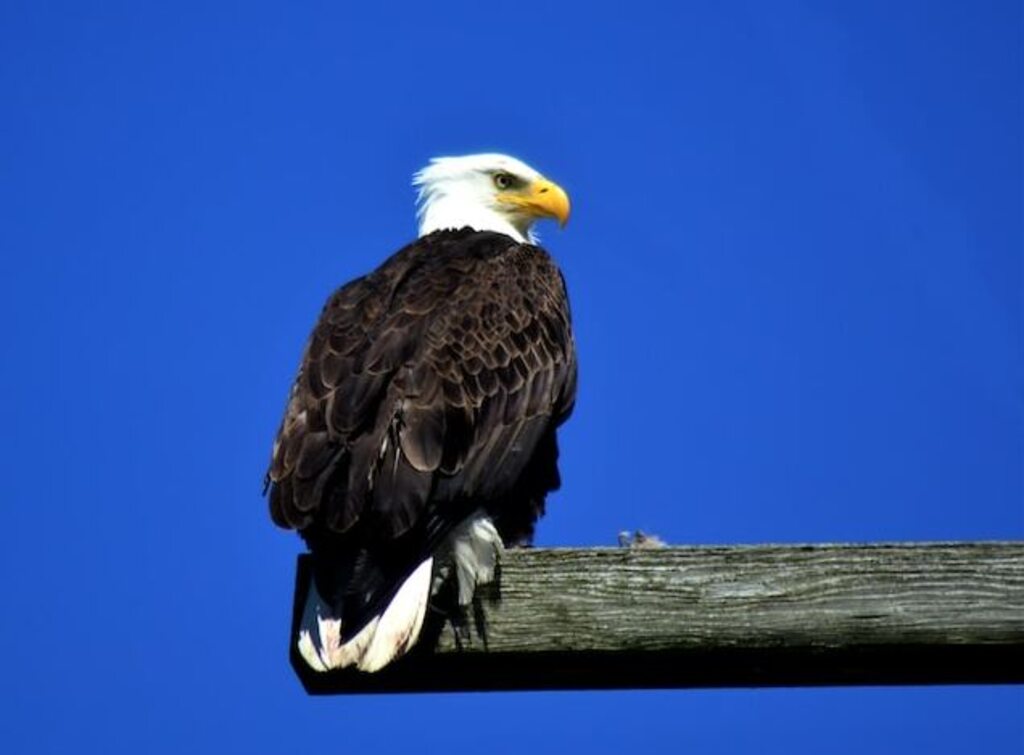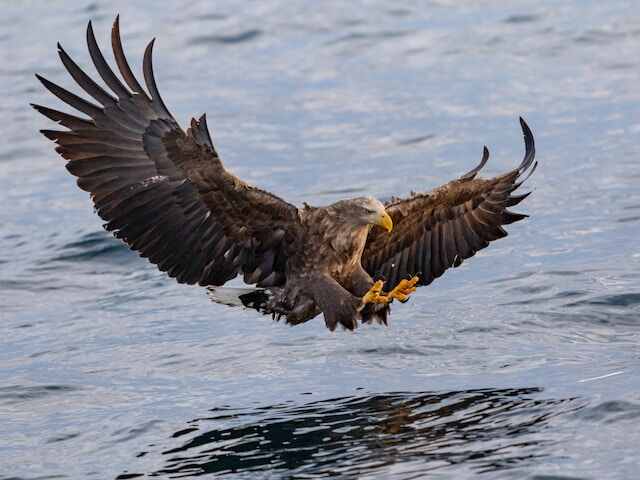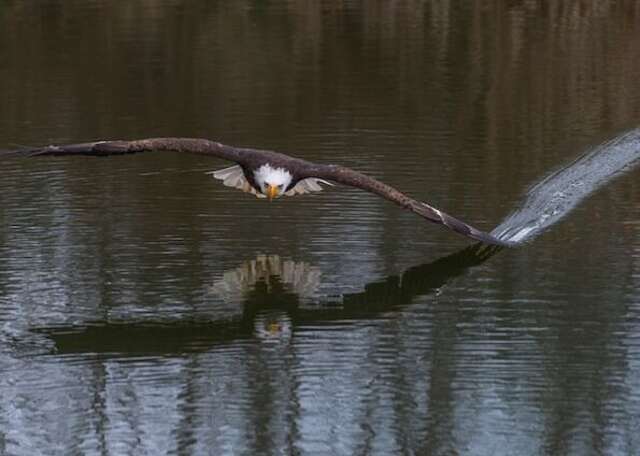Do Eagles Eat Eels? In the vast expanse of the natural world, where untamed winds carry ancient echoes, a majestic creature soars—the eagle.
With its piercing gaze and formidable wingspan, it captivates our imagination. This article unravels the enigmatic relationship between eagles and eels, exploring their diverse diet and hunting strategies.
Let’s dive into the intricate tapestry of nature and uncover the secrets that lie beneath the surface.
Table of Contents
- 1 Key Takeaways
- 2 Do Eagles Eat Eels
- 3 Overview of Eagle Diet and Hunting Techniques
- 4 Different Types of Prey for Eagles
- 5 Eels as a Potential Food Source for Eagles
- 6 Eagle Species That Have Been Observed Eating Eels
- 7 Hunting Strategies for Catching Eels
- 8 Challenges and Risks for Eagles when Hunting Eels
- 9 Other Factors Influencing Eagle’s Diet Choices
- 10 Research and Studies on Eagle-Eel Interactions
- 11 Importance of Understanding Eagle’s Diet for Conservation Efforts
- 12 Frequently Asked Questions
- 12.1 How do eagles locate and catch eels in the water?
- 12.2 Are all eagle species capable of eating eels or are there specific ones?
- 12.3 Do eagles primarily hunt eels in freshwater or saltwater environments?
- 12.4 Are there any risks or dangers associated with eating eels for eagles?
- 12.5 What other factors, besides eels, influence an eagle’s diet choices?
- 13 Conclusion
- 14 Author
Key Takeaways
- Eagles have a diverse diet that includes fish, small mammals, and birds, but they have also been observed consuming eels.
- Hunting eels presents challenges for eagles due to the eels’ slippery nature, sharp teeth, and defensive mechanisms.
- Eagles are more likely to consume eels when other food sources are scarce, indicating their dietary versatility.
- Understanding the complex interactions between eagles and eels is crucial for conservation efforts and preserving eagle populations.

Do Eagles Eat Eels
Yes, eagles do eat eels. While their diet primarily consists of fish, small mammals, and birds, certain eagle species have been observed consuming eels. This highlights the adaptability and resourcefulness of these majestic birds as they explore a diverse range of food sources in their natural habitats.
Overview of Eagle Diet and Hunting Techniques
Eagles employ a diverse and skillful array of hunting techniques, along with a varied diet that includes eels as a potential prey item.
They have developed specialized strategies to catch fish, which make up a significant portion of their diet. These strategies may involve aerial dives, swift swoops, or stealthily waiting near water bodies.
In the next section, we will explore the different types of prey for eagles and their hunting techniques for each.
Different Types of Prey for Eagles
This paragraph aims to introduce a discussion on the different types of prey for eagles, focusing on fish as a main food source, small mammals, and birds.
Eagles predominantly rely on fish as their primary food source, with some species specializing in catching fish from water bodies.
Additionally, eagles also hunt and consume small mammals such as rodents and rabbits, as well as various species of birds.
Understanding the diverse prey choices of eagles contributes to our knowledge of their ecological role and adaptations for hunting.
Fish as a Main Food Source
Fish, being a primary source of sustenance for many species, contribute significantly to the ecological balance of various ecosystems, with eels alone accounting for over 50% of the diet of certain predatory birds.
Fish species vary widely, from freshwater to saltwater, and provide essential nutrients such as omega-3 fatty acids and protein. Understanding the nutritional value of fish is crucial for evaluating their role in the diet of eagles.
Transitioning to the subsequent section, small mammals and birds also play a vital role in the diet of these majestic raptors.
Small Mammals and Birds
Small mammals and birds, integral to eagles’ diets, contribute to ecological balance and provide essential nutrients.
The behavior of small mammals, such as foraging and breeding patterns, influences the distribution and abundance of prey for eagles.
Likewise, bird migration patterns affect the availability of prey for eagles during different seasons.
Understanding the dynamics of these interactions is crucial for conserving eagle populations. Transitioning to eels, another potential food source for eagles, further explores their dietary versatility.

Eels as a Potential Food Source for Eagles
Eels have been considered a potential food source for eagles, as they offer a bountiful and diverse nourishment, akin to a buffet of sustenance for these majestic birds.
The eel migration patterns and eel farming techniques have provided valuable insights into the availability and accessibility of eels as prey for eagles.
Understanding the relationship between eels and eagles can shed light on the eagle species that have been observed feeding on eels, which will be discussed in the subsequent section.
Eagle Species That Have Been Observed Eating Eels
Several eagle species have been observed consuming eels, demonstrating the diverse dietary preferences and adaptability of these majestic birds.
Eagle eel interactions highlight the important role of eels as a potential food source for eagles.
These observations have implications for conservation efforts, as understanding the dietary needs and preferences of eagles can contribute to the preservation and management of their habitats.
Moving forward, it is crucial to explore the hunting strategies employed by eagles when catching eels.
Hunting Strategies for Catching Eels
Eagle species that have been observed eating eels employ a variety of hunting techniques and prey selection strategies.
They have adapted to the unique challenges presented by eel hunting, utilizing their keen eyesight and powerful talons to catch their slippery prey.
Some eagles employ a strategy of swooping down from great heights to snatch eels near the water’s surface, while others may wait patiently in trees or on the ground for an opportunity.
This section will explore the challenges and risks that eagles face when hunting eels.
Challenges and Risks for Eagles when Hunting Eels
This discussion focuses on the challenges and risks that eagles face when hunting eels.
Firstly, eels are known for their slippery and elusive nature, making them difficult prey to catch.
The eel’s ability to quickly wriggle and escape from the eagle’s grasp poses a significant challenge for successful hunting.
Additionally, eels possess sharp teeth and defensive mechanisms that can cause harm to the eagle during the hunting process.
Eel’s Slippery and Elusive Nature
Eels, known for their slippery and elusive nature, can effortlessly evade predators with their serpentine movements. To fully appreciate the challenges eagles face when hunting these slippery prey, consider the following:
- Eels can quickly change direction, making them difficult to catch.
- Their slimy skin allows them to easily slip out of a predator’s grasp.
- Eels can burrow into the mud or hide in crevices, making them hard to locate.
- Their ability to emit electric shocks can deter predators.
Understanding the elusive nature of eels helps us appreciate the potential dangers from their teeth and defense mechanisms, which will be discussed in the following section.
Potential Dangers from Eel’s Teeth and Defense Mechanisms
The potential dangers arising from the teeth and defense mechanisms of eels are a subject of fascination due to their ability to inflict harm and ward off predators.
Eel bites can be dangerous, as their teeth are sharp and can cause deep puncture wounds.
Additionally, eels have developed an array of defense mechanisms, including electric shocks and the ability to contort their bodies to escape predators.
Understanding these dangers and defense mechanisms is crucial in exploring other factors influencing eagle’s diet choices.

Other Factors Influencing Eagle’s Diet Choices
Another important factor to consider when studying the diet choices of eagles is the availability of alternative prey species.
Research has shown that eagles are more likely to consume eels when other food sources are scarce.
This is particularly relevant in the context of climate change, which can have a significant impact on local ecosystems and alter the abundance and distribution of prey species.
Understanding these influences is crucial for further research and studies on eagle-eel interactions.
Research and Studies on Eagle-Eel Interactions
Research and studies on the interactions between eagles and eels have provided valuable insights into the dynamics of their ecological relationship.
These investigations have shed light on factors such as the prey diversity of eagles, as well as the specific role that eels play in their diet.
Understanding the intricacies of eagle-eel interactions is crucial for conservation efforts aimed at preserving the delicate balance of ecosystems.
It is therefore important to delve into the significance of comprehending the eagle’s diet for effective conservation strategies.
Importance of Understanding Eagle’s Diet for Conservation Efforts
Understanding the dietary preferences of eagles is crucial in developing effective conservation strategies that can preserve the delicate balance of ecosystems.
By understanding what eagles eat, conservationists can ensure that the necessary food sources are protected.
This knowledge also allows for the identification of potential threats to eagle populations, such as declines in prey species.
Ultimately, understanding the eagle’s diet is essential for successful conservation efforts and the preservation of biodiversity.
- The importance of dietary studies for conservation efforts
Identifying key food sources for eagle populations
Mitigating threats to prey species
- The role of understanding eagle’s diet in ecosystem preservation
Maintaining the delicate balance of ecosystems
Ensuring the survival of other species that depend on the same food sources.

Frequently Asked Questions
How do eagles locate and catch eels in the water?
Eagles employ various hunting techniques to locate and catch eels in the water. By surveying their surroundings from great heights, they can spot the eels’ movements and swiftly dive down to seize their prey. This efficient hunting behavior reflects the eagle’s adaptability and resourcefulness.
Are all eagle species capable of eating eels or are there specific ones?
Different eagle species have varying diet preferences. While some eagles may eat eels, it is not a universal behavior. Each species has its own unique prey choices, which can include fish, mammals, birds, or even carrion.
Do eagles primarily hunt eels in freshwater or saltwater environments?
Eagles primarily hunt fish rather than eels. While some eagle species may occasionally consume eels, their diet preferences lean towards fish. The habitat plays a crucial role in determining the availability of fish or eels for eagle feeding habits.
Are there any risks or dangers associated with eating eels for eagles?
Eating eels can pose risks for eagles due to potential exposure to toxins and pollutants. However, eels are also a valuable source of nutrients such as protein, omega-3 fatty acids, and vitamins, which contribute to the overall nutritional value of their diet.
What other factors, besides eels, influence an eagle’s diet choices?
Eagle hunting techniques and the impact of habitat play significant roles in an eagle’s diet choices. Understanding these factors is crucial for comprehending the broader influences on an eagle’s feeding habits.

Conclusion
In conclusion, the diet of eagles is diverse and includes various types of prey, including eels. Different species of eagles have been observed consuming eels, showcasing their adaptability and hunting prowess.
Hunting strategies employed by eagles when catching eels are complex, and they face challenges and risks in the process.
Understanding the factors influencing eagle’s diet, such as the availability of different prey options, is crucial for conservation efforts.
Further research and studies on eagle-eel interactions are needed to deepen our understanding of these majestic birds.



